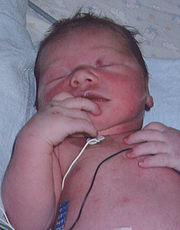
Blue baby syndrome
Encyclopedia

Layman
A layperson or layman is a person who is not an expert in a given field of knowledge. The term originally meant a member of the laity, i.e. a non-clergymen, but over the centuries shifted in definition....
's term used to describe newborns with cyanotic heart lesions, such as
- Persistent Truncus ArteriosusPersistent truncus arteriosusPersistent truncus arteriosus , also known as Common arterial trunk, is a rare form of congenital heart disease that presents at birth...
- Transposition of the great vesselsTransposition of the great vesselsTransposition of the great vessels is a group of congenital heart defects involving an abnormal spatial arrangement of any of the primary blood vessels: superior and/or inferior vena cavae , pulmonary artery, pulmonary veins, and aorta...
- Tricuspid atresiaTricuspid atresiaTricuspid atresia is a form of congenital heart disease whereby there is a complete absence of the tricuspid valve. Therefore, there is an absence of right atrioventricular connection. This leads to a hypoplastic or absent right ventricle....
- Tetralogy of FallotTetralogy of FallotTetralogy of Fallot is a congenital heart defect which is classically understood to involve four anatomical abnormalities...
- Total Anomalous Pulmonary Venous Return
Other causes
A sort of "blue baby syndrome" can also be caused by MethemoglobinemiaMethemoglobinemia
Methemoglobinemia is a disorder characterized by the presence of a higher than normal level of methemoglobin in the blood. Methemoglobin is an oxidized form of hemoglobin that has an increased affinity for oxygen, resulting in a reduced ability to release oxygen to tissues. The oxygen–hemoglobin...
. It is believed to be caused by high nitrate contamination in ground water resulting in decreased oxygen carrying capacity of hemoglobin in babies leading to death. The groundwater is thought to be contaminated by leaching of nitrate generated from fertilizer used in agricultural lands and waste dumps. It may also be related to some pesticides (DDT, PCBs etc), which cause ecotoxicological problems in the food chains of living organisms, increasing BOD
Biochemical oxygen demand
Biochemical oxygen demand or B.O.D. is the amount of dissolved oxygen needed by aerobic biological organisms in a body of water to break down organic material present in a given water sample at certain temperature over a specific time period. The term also refers to a chemical procedure for...
, which kills aquatic animals.
Other insults in neonates, such as respiratory distress syndrome, can also produce a "blue baby syndrome," although like methemoglobinemia, these are not structural lesions and are not regarded by most doctors as true "cyanotic lesions."
Surgery
On November 29, 1944, the Johns Hopkins HospitalJohns Hopkins Hospital
The Johns Hopkins Hospital is the teaching hospital and biomedical research facility of Johns Hopkins University School of Medicine, located in Baltimore, Maryland . It was founded using money from a bequest by philanthropist Johns Hopkins...
was the first to successfully perform an operation to relieve Tetralogy of Fallot
Tetralogy of Fallot
Tetralogy of Fallot is a congenital heart defect which is classically understood to involve four anatomical abnormalities...
. The syndrome was brought to the attention of surgeon Alfred Blalock
Alfred Blalock
Alfred Blalock was a 20th-century American surgeon most noted for his research on the medical condition of shock and the development of the Blalock-Taussig Shunt, surgical relief of the cyanosis from Tetralogy of Fallot—known commonly as the blue baby syndrome—with Vivien Thomas and pediatric...
and his laboratory assistant Vivien Thomas
Vivien Thomas
Vivien Theodore Thomas was an African-American surgical technician who developed the procedures used to treat blue baby syndrome in the 1940s...
in 1943 by pediatric cardiologist Helen Taussig, who had treated hundreds of children with Tetralogy of Fallot
Tetralogy of Fallot
Tetralogy of Fallot is a congenital heart defect which is classically understood to involve four anatomical abnormalities...
in her work at Hopkins' Harriet Lane Home for Invalid Children. The two men adapted a surgical procedure they had earlier developed for another purpose, involving the anastomosis
Anastomosis
An anastomosis is the reconnection of two streams that previously branched out, such as blood vessels or leaf veins. The term is used in medicine, biology, mycology and geology....
, or joining, of the subclavian artery
Subclavian artery
In human anatomy, the subclavian arteries are two major arteries of the upper thorax , below the clavicle . They receive blood from the top of the aorta...
to the pulmonary artery
Pulmonary artery
The pulmonary arteries carry deoxygenated blood from the heart to the lungs. They are the only arteries that carry deoxygenated blood....
, which allowed the blood another chance to become oxygen
Oxygen
Oxygen is the element with atomic number 8 and represented by the symbol O. Its name derives from the Greek roots ὀξύς and -γενής , because at the time of naming, it was mistakenly thought that all acids required oxygen in their composition...
ated. The procedure became known as the Blalock-Taussig shunt
Blalock-Taussig shunt
The Blalock–Taussig shunt is a surgical procedure to give palliation to cyanotic heart defects which are common causes of blue baby syndrome...
, although in recent years the contribution of Vivien Thomas
Vivien Thomas
Vivien Theodore Thomas was an African-American surgical technician who developed the procedures used to treat blue baby syndrome in the 1940s...
, both experimentally and clinically, has been widely acknowledged.

